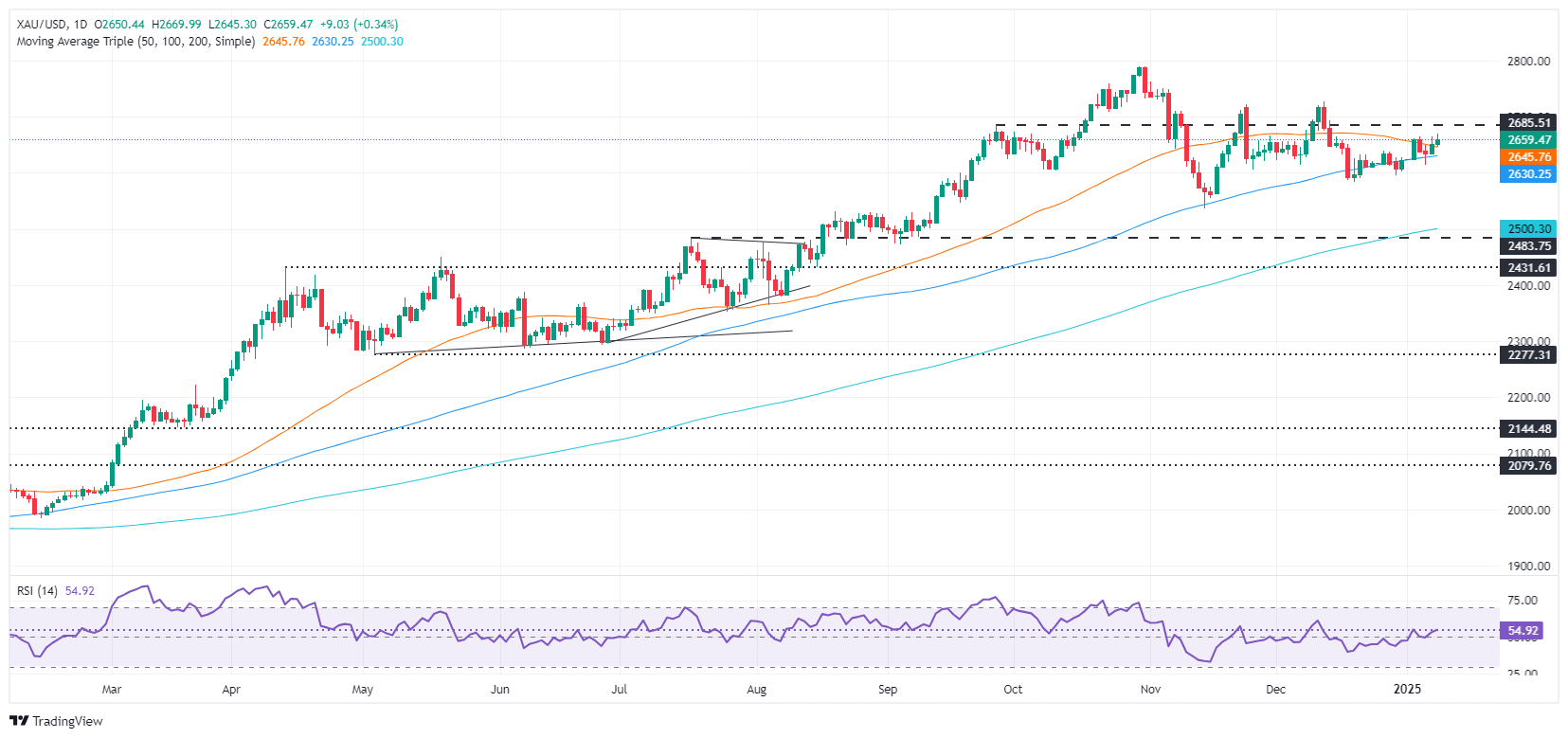- Gold climbs following Fed minutes hinted at a potential slowdown in the rate easing cycle.
- US Dollar Index maintains gains, while US Treasury yields show a slight pullback from recent highs.
- Gold market watchers eye US Nonfarm Payrolls report and UoM Consumer Sentiment data.
Gold price climbed during the North American session after the United States (US) Federal Reserve (Fed) struck a neutral to slightly hawkish tone in last December meeting minutes, hinting that it “would be appropriate to slow pace of easing.” At the time of writing, XAU/USD trades at $2,659, up by 0.34%.
During the December meeting, officials decided to lower borrowing costs by 25 basis points. However, “some participants said there was merit in keeping rates unchanged at that meeting, citing the higher risk of persistently elevated inflation.” Following the minutes’ release, XAU/USD edged towards $2,658 before paring some of those gains.
The US Dollar Index (DXY), which measures the Greenback’s performance against a basket of six currencies, holds to earlier gains of 0.33% at 109.04. The US 10-year benchmark note coupon retraced after hitting 4.73% to 4.699%, up by three basis points (bps).
Earlier, market participants shifted wary of a CNN article revealing that US President-elect Donald Trump might consider a national economic emergency declaration, allowing him to impose tariffs on adversaries and allies.
Bullion buyers ignored mixed US jobs reports, as private companies hired fewer people than expected. However, the US Department of Labor revealed that Americans' applications for jobless benefits were reduced compared to the previous week and came below forecasts.
Fed Governor Christopher Waller crossed the wires and said that tariffs would not cause persistent inflation, which would continue to fall towards the Fed’s 2% goal. Waller added that he favors further rate cuts, which would be data-dependent.
In the meantime, Gold traders are eyeing Friday's release of the US Nonfarm Payroll report and the University of Michigan (UoM) Consumer Sentiment. If both readings come stronger than expected, the XAU/USD might edge lower on broad US Dollar strength.
Daily digest market movers: Gold price climbs amid high US yields, ignore US data
- Gold shrugs off higher US real yields, rising three bps to 2.31%.
- Initial Jobless Claims in the US dropped to 201K for the week ending January 3, down from 211K and well below the forecast of 218K, according to the Department of Labor.
- ADP reported that private sector hiring totaled 122K in December, falling short of the 140K expected by economists.
- Market expectations indicate the Federal Reserve may implement two rate cuts in 2025, with the December Fed funds futures contract pricing in 54 basis points of easing.
- Gold surged to a two-day high of $2,664 following news that China’s central bank increased its reserves for the second consecutive month, adding 300K ounces to reach 73.3 million. The People's Bank of China (PBoC) resumed bullion purchases, which could keep XAU/USD prices skewed to the upside.
XAU/USD technical outlook: Gold price surges above $2,650
Gold price remains consolidated but slightly tilted to the upside after reclaiming the 50-day Simple Moving Average (SMA) at $2,648. If bulls push prices above $2,660, it will pave the way to challenge $2,700 before testing the December 12 peak at $2,726, ahead of the record high at $2,790.
On the flip side, if sellers drag the XAU/USD below the 100-day SMA of $2,628, look for a test of $2,500 before Gold extends its losses to the 200-day SMA at $2,498.
Gold FAQs
Gold has played a key role in human’s history as it has been widely used as a store of value and medium of exchange. Currently, apart from its shine and usage for jewelry, the precious metal is widely seen as a safe-haven asset, meaning that it is considered a good investment during turbulent times. Gold is also widely seen as a hedge against inflation and against depreciating currencies as it doesn’t rely on any specific issuer or government.
Central banks are the biggest Gold holders. In their aim to support their currencies in turbulent times, central banks tend to diversify their reserves and buy Gold to improve the perceived strength of the economy and the currency. High Gold reserves can be a source of trust for a country’s solvency. Central banks added 1,136 tonnes of Gold worth around $70 billion to their reserves in 2022, according to data from the World Gold Council. This is the highest yearly purchase since records began. Central banks from emerging economies such as China, India and Turkey are quickly increasing their Gold reserves.
Gold has an inverse correlation with the US Dollar and US Treasuries, which are both major reserve and safe-haven assets. When the Dollar depreciates, Gold tends to rise, enabling investors and central banks to diversify their assets in turbulent times. Gold is also inversely correlated with risk assets. A rally in the stock market tends to weaken Gold price, while sell-offs in riskier markets tend to favor the precious metal.
The price can move due to a wide range of factors. Geopolitical instability or fears of a deep recession can quickly make Gold price escalate due to its safe-haven status. As a yield-less asset, Gold tends to rise with lower interest rates, while higher cost of money usually weighs down on the yellow metal. Still, most moves depend on how the US Dollar (USD) behaves as the asset is priced in dollars (XAU/USD). A strong Dollar tends to keep the price of Gold controlled, whereas a weaker Dollar is likely to push Gold prices up.
Information on these pages contains forward-looking statements that involve risks and uncertainties. Markets and instruments profiled on this page are for informational purposes only and should not in any way come across as a recommendation to buy or sell in these assets. You should do your own thorough research before making any investment decisions. FXStreet does not in any way guarantee that this information is free from mistakes, errors, or material misstatements. It also does not guarantee that this information is of a timely nature. Investing in Open Markets involves a great deal of risk, including the loss of all or a portion of your investment, as well as emotional distress. All risks, losses and costs associated with investing, including total loss of principal, are your responsibility. The views and opinions expressed in this article are those of the authors and do not necessarily reflect the official policy or position of FXStreet nor its advertisers. The author will not be held responsible for information that is found at the end of links posted on this page.
If not otherwise explicitly mentioned in the body of the article, at the time of writing, the author has no position in any stock mentioned in this article and no business relationship with any company mentioned. The author has not received compensation for writing this article, other than from FXStreet.
FXStreet and the author do not provide personalized recommendations. The author makes no representations as to the accuracy, completeness, or suitability of this information. FXStreet and the author will not be liable for any errors, omissions or any losses, injuries or damages arising from this information and its display or use. Errors and omissions excepted.
The author and FXStreet are not registered investment advisors and nothing in this article is intended to be investment advice.
Recommended content
Editors’ Picks

AUD/USD: Door open to extra weakness
AUD/USD retreated for the third consecutive day, breaking below the 0.6300 support to challenge the provisional 55-day SMA, always on the back of further gains in the Greenback and a poor labour market report in Australia.

EUR/USD looks under pressure, survives above the 200-day SMA
EUR/USD succumbed to the continuation of the bid bias in the Greenback, adding to post-Fed losses and coming closer to the key 1.0800 neighbourhood on Thursday.

Gold corrective slide may be complete
After hitting a record high above $3,050 early Thursday, Gold retraced to the $3,030 region amid the stronger Dollar and diminishing US yields, all amid investors' repricing of the latest FOMC event.

Meme coin platform Pumpfun launches PumpSwap, promising creator revenue sharing
Solana meme coin generator Pumpfun announced on Thursday the launch of its own native decentralized exchange (DEX), PumpSwap, to facilitate the trading of meme coins and other SOL-based crypto tokens.

Tariff wars are stories that usually end badly
In a 1933 article on national self-sufficiency1, British economist John Maynard Keynes advised “those who seek to disembarrass a country from its entanglements” to be “very slow and wary” and illustrated his point with the following image: “It should not be a matter of tearing up roots but of slowly training a plant to grow in a different direction”.

The Best brokers to trade EUR/USD
SPONSORED Discover the top brokers for trading EUR/USD in 2025. Our list features brokers with competitive spreads, fast execution, and powerful platforms. Whether you're a beginner or an expert, find the right partner to navigate the dynamic Forex market.
